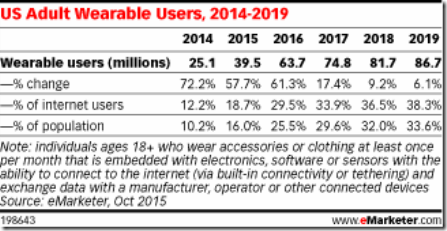connected devices
1 TopicConnecting the Threads
What was first used to protect humans from the outside elements is now monitoring our body's inside environment. According to eMarketer.com, wearable usage will grow almost 60% in 2015 verses 2014. This year, almost 40 million U.S. adults will use wearables, including smartwatches and fitness trackers. And that's only 16% of the penetrable market. They expect that number double in two years with close to 82 million adults wearing something connected by 2018. Almost two in five internet users by 2019. You probably think that it'll be all those youngsters growing up with connected objects but over the next four years, older Americans will see the biggest growth with the flood of wearable health monitor devices. Don't fret, I'm sure that new outfit for special occasions will monitor something. These connected wearables will soon be able to cover our body. Even with that growth, adults are still exploring the value of wearables, above the wow-cool factor, for the real benefit of the investment. With prices still high for many of these gadgets, the adoption will be slightly lower than the recent mad rush for smartphones and tablets. Yet like many new technologies, as sticker-shock drops, the adoption grows. In addition, as more apps are developed to work with this new wardrobe, more people are likely to use it...just like the mobile device market. After all, that's what these things are - mobile devices. And once that happens, the advertisers will be all over that segment, which is currently very sparse. And what typically follows mass adoption of technology? Vulnerabilities and security risks. More connected personal devices in the office means more enterprise security risks. Whether it be from smartwatches having access to sensitive corporate data or the lost bandwidth from all the updates and alerts sent to these devices. Corporate BYOD security policies could soon include smartwatch use or any other wearable that poses a risk to the organization. As Steven Wright says, 'Right now I'm having amnesia and déjà vu at the same time.' BYO2.0 And we haven't even touched on the lack of security being built into some of these devices. From insulin pumps, to glucose meters to pacemakers, anything that is wireless enabled is vulnerable to attack. While the bad guys are always looking for an easy score, it could also be the disgruntled employee looking to fix someone's wagon. And when I say fix, I really mean break. There are also privacy concerns for those who might be wearing smart eyewear. That casual, always awkward conversation at the urinal now takes on new meaning. For highly sensitive meetings, there could be a clothes rack and changing station so someone doesn't need to strip down just to participate. Forget about spy pens with wireless mics, my shirt's logo has a camera weaved into the seam. All is not lost though, as there will be plenty of top 10 lists guiding you so you do not become a social (real world) outcast. WT VOX has put together it's Top 10 Worst Wearable Tech Devices So Far list. From a tie that has a QR code built into its back, to smartwigs, selfie-hats and drum pants, they explore the wild gadgets that are clamoring to cover our body. And on the flip side, they also look at the 10 Wearables and IoT Companies To Watch In 2015. Here, you get a glimpse of the future of smart lighting, dealing with big data, new IoT chipsets, IoT cloud platforms and other entities focused on our networked society. Hashtag: Amazing. ps Related: Wearable Usage Will Grow by Nearly 60% This Year The Dark Side of Wearable Tech Use Top 10 Worst Wearable Tech Devices So Far 10 Wearables and IoT Companies To Watch In 2015 Wearables Head to Tail Oh, Is That The Internet You're Wearing? The Digital Dress Code IoT Influence on Society Technorati Tags: wearables,iot,things,connected devices,security,privacy,silva Connect with Peter: Connect with F5:406Views0likes0Comments
